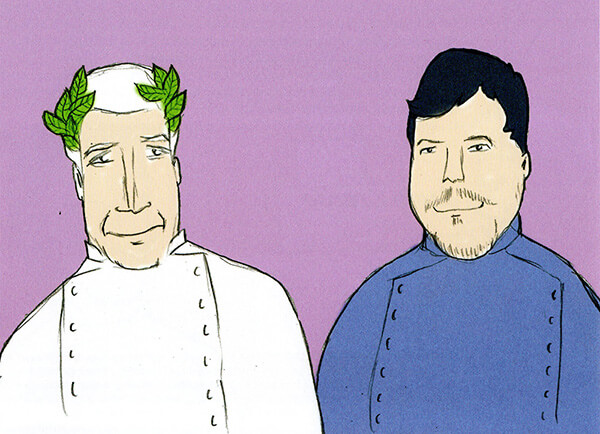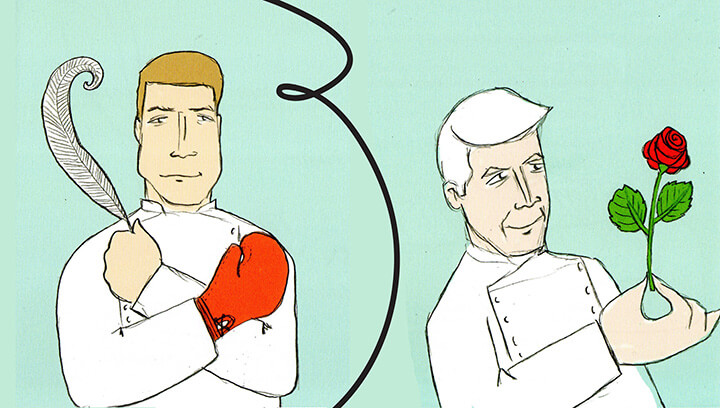When notable Italian pastry chef Iginio Massari was asked to describe the future of the pastry and the new direction that it’s taking, he spoke of change, a separation from some traditions and a moment for breaking new ground.
A PICTURE OF THE FUTURE
If we take a look at the world around us, if we really consider what marks the times in which we live, one aspect which dominates is change. Change is everywhere. The borders between nations aren’t as impossible as they were before, there are religious beliefs that have mutated and even disappeared, science has advanced rapidly, and yet what is true today might be different tomorrow.
In the midst of all this is food, something vital and appreciated by all, unchanged. Yet it would be impossible to think that as the world around us reinvents itself so quickly none of this could have a domino effect on how we eat. It does. It has.
Food has been reinvented and is exciting, and of course, this is true for the world of sweets as well. Today’s pastry chefs are exploring and taking their craft in new directions, each of them with their own vision for the future of the delectable sweets.
FOOD WITH A MESSAGE
Food speaks. It tells us innumerable things about a culture, a person, a location, and a preference. It can be the history of a place impacted by the context of the day. What we choose to eat and how we eat it is at once where we were and where we will be. So, how can a pastry chef transmit this to his customers? It isn’t enough to simply have an aesthetic impact, nor is it enough to just taste delicious.
A customer demands both, and the pastry chef must mix both the right method and the best context to deliver the personal message he has to offer while serving up a product that is pleasing to both the eye and the palette.
In a pastry shop, the time to truly interact with customers can be quite limited. Most people spend under five minutes choosing their cake or pastry. They may have even double-parked and literally pop in, glanced at the display case, maDe a choice, and were out the door in the flash of an eye. Other times a customer is looking for something more particular for an occasion, for example, and they expect the pastry chef to be quick in understanding exactly what they have in mind… then the pastry chef becomes a sugar-sprinkled mind reader if you will.
Maybe a pastry chef working in a restaurant has ample ground to express him or herself to their customers. Here the context is different. People slow down for a meal out. They’re relaxed and are enjoying the experience. Customers can take their own ‘sweet’ time to read and reread the dessert menu and ask for advice from the waiter. Here the details emerge – the layers, the flavors, the beauty. Maybe here there is a clearer dialogue between the chef and a well-satisfied customer.

VARIETY OR VARIATION
A pastry shop chooses to offer either one or the other. Is it better to excel in the creation of a single product or to create a little bit of this and a little bit of that? The answer to this may come down to which country you find yourself in.
Take the queen of the pastry… France. No country in the world unseats France as the world’s best in pastry making. Decadent. Refined. Pretty. Petite. In France, many pastry shops specialize in one product, for example, the eclair, the macaroon, or chocolate. French sweets are a luxury and often the price tag reflects this. There are high-end specialty shops where sweets might run up to 70 or even 200 euros per kilo!
Then just south of France lies Italy. Another country so well-known throughout the world for its excellent cuisine. Is it the same to the south of the Alps? Not at all. Italian sweets are delicious but they aren’t considered a luxury product like they might be in France. They need to be just one thing – good, and Italians are not willing to spend levitated prices for a cake or pastry.
Italians would call this a crime no matter how excellent it is. In Italy a pastry chef and his team must find a way to bake high quality, innovative products which reflect their unique style and offer them at the right price. For the past 40 years this has been the state of pastry making in Italy.

THE ART OF THE PASTRY
Making pastry is like making a work of art – like bringing together aesthetics, music, and thought all in one. It is like architecture and even, at times, like science. There are moments when it can be like building an 800-floor skyscraper and making it stay up. Chefs must know their ingredients and combine them like magic while mastering the techniques necessary to give creative and new forms to their delicious masterpieces.
AESTHETICS AND MODERN CAKE MAKING
Customers are first attracted by the beauty of the pastry. It is the first element of attraction but it isn’t everything. If a person buys the loveliest cake in the shop but it isn’t as delicious as it is beautiful you’ve let your customer down.
Iginio believes that today’s pastries must lean towards simplicity and truth. What is on the outside must be equally reflected on the inside, otherwise you risk transmitting a false message. For example, any fruit used to decorate the outside of a cake must be used in proportion to the intensity of fruit flavors on the inside of the cake. If there is a fruit cream on the inside, then it’s better to use less fruit on the outside to maintain a balance.
A pastry chef has to always keep in mind the difference between taste and flavor. Simplicity must never threaten to become dull.
PASTRIES AND HEALTH
What would the doctor say about each and every trip to the pastry shop? Are all of those goodies in the showcase a risk to your health and waistline?
Iginio has his ideas. Each doctor has his thought on which foods are considered ok and which aren’t. I think that there really isn’t any natural ingredient that is either good for us or harmful in and of itself. It depends on the individual, their health, and their genetic predispositions.
Obviously, I’m a pastry chef and not a doctor at a hospital. When you walk into a pastry shop it’s obvious that you’re not walking into a pharmacy. Of course, there will always be specialists who go beyond their own field of expertise… But in any case, all I can say is that I’ve seen that even vegetarians age just like everybody else, maybe even earlier!
SAVORY PASTRIES AND DRINK PAIRINGS
Mixing savory pastries and drinks in an Italian pastry shop is still quite a challenge at the moment. This idea has taken off in countries such as Germany and Switzerland where there are places where people can go for food and drink tastings and even savory pastries are paired with cocktails, wines, and spirits. In Italy, savory pastries are sometimes available in pastry shops but as a takeaway food and not as something to be eaten there.
PASTRY AND THE MEDIA
Recent years have seen an invasion of cooking shows on television and the pastry has become one of the protagonists of programs where people watch, learn, and compete. The ideas for these types of shows began in the U.S. and eventually invaded Italian programming as well… and with great success, instilling a greater interest in American pastry products which are quite different from those found traditionally in Italy.
Involving the public in the concept of pastry creation is most definitely an idea that should be cultivated. These shows are surely part of our future. The fact that pastry chefs have a greater opportunity to interact with the media who in turn can transmit a greater knowledge and appreciation for this sector amongst the public is a very good thing.
 TECHNOLOGY, MACHINES, AND TEACHING BY IGINIO MASSARI
TECHNOLOGY, MACHINES, AND TEACHING BY IGINIO MASSARI
I created Cast Alimenti twenty years ago as a way to raise the level of Italian pastry making. Cast Alimenti is a culinary school located in the northern Italian city of Brescia.
It prepares its students for various facets of the food industry including becoming culinary and pastry chefs and also entering into management and non-cooking professions related to food as well.
We use top Italian-made machines in our pastry schools. These machines are made in Italy and are exported all over the world.
Today’s top pastries cannot be made without the help of technology. This is the world. This is progress and innovation. A sweet made exclusively by hand in a pastry kitchen is like a wine made just by smashing the grapes with our feet. It’s outdated and the quality would suffer greatly. Chefs must use both their minds and machines to create top products in this day and age. It’s time to let go of a few of the old ways to make room for the new.
Young chefs learn to use the latest technology available in pastry kitchens to enhance their talents.
These new Italian pastry chefs of tomorrow have a much greater desire to learn compared to those in the past. This is another reason why the future of Italian pastries seems to be getting sweeter and sweeter!
Thanks to Iginio Massari for his time and thoughts.
—
Illustrations by Gianluca Biscalchin, from the book ‘Iginio Massari. Accademia Maestri Pasticceri Italiani 1993-2013 – Vent’anni e non sentirli.’ Pubished by Pavoni Italia and Italian Gourmet.
[A jewel in pages as mirrors which reflects the friendships and esteem between professionals who share a great passion for what they do].